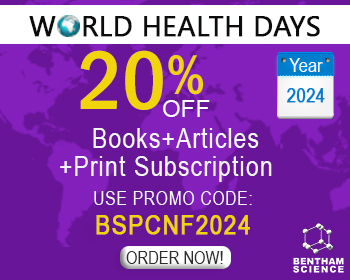Abstract
Bromodomains recognize and bind acetyl-lysine residues present in histone and non-histone proteins in a specific manner. In the last decade they have raised as attractive targets for drug discovery because the miss-regulation of human bromodomains was discovered to be involved in the development of a large spectrum of diseases. However, targeting eukaryotic pathogens bromodomains continues to be almost unexplored. We and others have reported the essentiality of diverse bromodomain- containing proteins in protozoa, offering a new opportunity for the development of antiparasitic drugs, especially for Trypansoma cruzi, the causative agent of Chagas’ disease. Mammalian bromodomains were classified in eight groups based on sequence similarity but parasitic bromodomains are very divergent proteins and are hard to assign them to any of these groups, suggesting that selective inhibitors can be obtained. In this review, we describe the importance of lysine acetylation and bromodomains in T. cruzi as well as the current knowledge on mammalian bromodomains. Also, we summarize the myriad of small-molecules under study to treat different pathologies and which of them have been tested in trypanosomatids and other protozoa. All the information available led us to propose that T. cruzi bromodomains should be considered as important potential targets and the search for smallmolecules to inhibit them should be empowered.
Keywords: Bromodomains, trypanosoma cruzi, acetylation, bromodomain inhibitors, chagas diseases, drug discovery.
[http://dx.doi.org/10.1016/j.molbiopara.2007.07.007] [PMID: 17765983]
[http://dx.doi.org/10.1128/MMBR.00024-10] [PMID: 21119017]
[http://dx.doi.org/10.1155/2010/525241] [PMID: 20169133]
[http://dx.doi.org/10.1016/j.micinf.2003.09.005] [PMID: 14623019]
[http://dx.doi.org/dx.doi: 10.1042/bse0510031] [PMID: 22023440]
[http://dx.doi.org/10.1016/S1097-2765(03)00143-6] [PMID: 12769852]
[http://dx.doi.org/10.1128/EC.3.2.506-517.2004] [PMID: 15075279]
[http://dx.doi.org/10.1093/nar/gks1469] [PMID: 23361461]
[http://dx.doi.org/10.1371/journal.ppat.1003010] [PMID: 23133390]
[http://dx.doi.org/10.1016/j.molbiopara.2013.09.005] [PMID: 24080031]
[http://dx.doi.org/10.1101/gad.1790409] [PMID: 19369410]
[http://dx.doi.org/10.1016/j.febslet.2006.03.044] [PMID: 16580668]
[http://dx.doi.org/10.1021/acs.jproteome.6b00208] [PMID: 27108550]
[http://dx.doi.org/10.1007/s00412-009-0213-9] [PMID: 19396454]
[http://dx.doi.org/10.1016/j.pt.2007.04.006] [PMID: 17459774]
[http://dx.doi.org/10.1016/j.molbiopara.2007.07.005] [PMID: 17714803]
[http://dx.doi.org/10.1021/acs.jproteome.6b00655] [PMID: 28076955]
[http://dx.doi.org/10.1111/j.1365-3024.2011.01347.x] [PMID: 22132795]
[http://dx.doi.org/10.1074/jbc.M802081200] [PMID: 18400752]
[http://dx.doi.org/10.1186/1471-2164-10-152] [PMID: 19356248]
[http://dx.doi.org/10.1128/EC.05185-11] [PMID: 21926332]
[http://dx.doi.org/10.1155/2012/452934] [PMID: 23093844]
[http://dx.doi.org/10.1111/mmi.12303] [PMID: 23796209]
[http://dx.doi.org/10.1128/EC.00088-12] [PMID: 22544907]
[http://dx.doi.org/10.1021/acs.jproteome.7b00603] [PMID: 29168382]
[http://dx.doi.org/10.1590/S0074-02762009000900014] [PMID: 19753463]
[http://dx.doi.org/10.1590/S0074-02761993000400004] [PMID: 8139463]
[http://dx.doi.org/10.1083/jcb.104.3.431] [PMID: 3818788]
[http://dx.doi.org/10.1146/annurev.mi.41.100187.001015] [PMID: 3120638]
[http://dx.doi.org/10.1042/BJ20150986] [PMID: 26500280]
[http://dx.doi.org/10.1016/0092-8674(92)90191-E] [PMID: 1346755]
[http://dx.doi.org/10.1093/nar/28.1.235] [PMID: 10592235]
[http://dx.doi.org/10.1038/20974] [PMID: 10365964]
[http://dx.doi.org/10.1016/S1097-2765(03)00528-8] [PMID: 14759370]
[http://dx.doi.org/10.1016/j.str.2008.01.010] [PMID: 18400184]
[http://dx.doi.org/10.1016/j.str.2013.10.021] [PMID: 24361270]
[http://dx.doi.org/10.1016/j.cell.2012.02.013] [PMID: 22464331]
[http://dx.doi.org/10.1128/MCB.05413-11] [PMID: 21555453]
[http://dx.doi.org/10.1016/j.bmc.2011.10.080] [PMID: 22137933]
[http://dx.doi.org/10.1038/cr.2010.43] [PMID: 20368734]
[http://dx.doi.org/10.1074/jbc.M109.062422] [PMID: 20048151]
[http://dx.doi.org/10.1093/emboj/19.22.6141] [PMID: 11080160]
[http://dx.doi.org/10.1016/j.bbagrm.2014.03.011] [PMID: 24686119]
[PMID: 19736624]
[http://dx.doi.org/10.1093/nar/gkv1344] [PMID: 26673716]
[http://dx.doi.org/10.1126/science.1063127] [PMID: 11498575]
[http://dx.doi.org/10.1038/nrm.2016.143] [PMID: 28053347]
[http://dx.doi.org/10.1371/journal.ppat.1005366] [PMID: 26727473]
[http://dx.doi.org/10.1016/j.devbrainres.2003.12.011] [PMID: 15063089]
[http://dx.doi.org/10.1002/mrd.20059] [PMID: 15112318]
[http://dx.doi.org/10.1369/jhc.7A7340.2007] [PMID: 18071067]
[http://dx.doi.org/10.1128/MCB.01297-08] [PMID: 18794358]
[http://dx.doi.org/10.1093/emboj/19.15.4123] [PMID: 10921892]
[http://dx.doi.org/10.1016/j.fgb.2015.01.011] [PMID: 25656079]
[http://dx.doi.org/10.1093/molbev/msr121] [PMID: 21546353]
[http://dx.doi.org/10.1128/EC.00341-13] [PMID: 24747213]
[http://dx.doi.org/10.1016/j.ijpara.2008.11.013] [PMID: 19136002]
[http://dx.doi.org/10.1111/febs.13719] [PMID: 27007774]
[http://dx.doi.org/10.1016/j.exppara.2012.01.020] [PMID: 22343032]
[http://dx.doi.org/10.1016/j.bbamcr.2015.09.015] [PMID: 26384872]
[http://dx.doi.org/10.1126/science.1179689] [PMID: 20167786]
[http://dx.doi.org/10.2741/Horn] [PMID: 11487477]
[http://dx.doi.org/10.1042/BCJ20170619] [PMID: 29025975]
[http://dx.doi.org/10.1371/journal.pbio.1002316] [PMID: 26646171]
[http://dx.doi.org/10.1093/nar/gks813] [PMID: 22941664]
[http://dx.doi.org/10.1038/nchembio.2007.18] [PMID: 17643111]
[http://dx.doi.org/10.1038/nchembio.2007.16] [PMID: 17643112]
[http://dx.doi.org/10.1038/nature09504] [PMID: 20871596]
[http://dx.doi.org/10.1021/jm200108t] [PMID: 21568322]
[http://dx.doi.org/10.1038/nature10509] [PMID: 21964340]
[http://dx.doi.org/10.1177/1087057111421372] [PMID: 21956175]
[http://dx.doi.org/10.1016/j.chembiol.2010.12.021] [PMID: 21513889]
[http://dx.doi.org/10.1126/science.274.5292.1531] [PMID: 8929414]
[http://dx.doi.org/10.2174/156802607782341073] [PMID: 17979772]
[http://dx.doi.org/10.1038/nprot.2007.321] [PMID: 17853878]
[http://dx.doi.org/10.1073/pnas.0708800104] [PMID: 18077363]
[http://dx.doi.org/10.1038/nature09589] [PMID: 21068722]
[http://dx.doi.org/10.1039/c1mb05099k] [PMID: 21804994]
[http://dx.doi.org/10.1039/C7MD00083A] [PMID: 30108844]
[http://dx.doi.org/10.1517/13543776.2014.859244] [PMID: 24261714]
[http://dx.doi.org/10.1021/jm201283q] [PMID: 22136469]
[http://dx.doi.org/10.1021/ja107761h] [PMID: 21271695]
[http://dx.doi.org/10.1002/cmdc.201300499] [PMID: 24474698]
[http://dx.doi.org/10.1111/febs.13719] [PMID: 27007774]
[http://dx.doi.org/10.1021/acscombsci.7b00172] [PMID: 29481050]
[http://dx.doi.org/10.1021/acsmedchemlett.8b00247] [PMID: 30344907]
[http://dx.doi.org/10.1016/j.bmcl.2012.01.125] [PMID: 22386529]
[http://dx.doi.org/10.1016/j.chembiol.2011.02.009] [PMID: 21513886]
[http://dx.doi.org/10.1186/1756-8935-7-14] [PMID: 25097667]
[http://dx.doi.org/10.1093/bioinformatics/btu052] [PMID: 24470572]
[http://dx.doi.org/10.1021/jm300915b] [PMID: 22924434]
[http://dx.doi.org/10.1021/cb500996u] [PMID: 25549280]
[http://dx.doi.org/10.1016/j.cbpa.2016.05.028] [PMID: 27295577]
[http://dx.doi.org/10.1021/jm401088k] [PMID: 24015967]
[http://dx.doi.org/10.1021/jm5010539] [PMID: 25249180]
[http://dx.doi.org/10.18632/oncotarget.4131] [PMID: 25989842]
[http://dx.doi.org/10.1038/cddis.2014.396] [PMID: 25299775]
[http://dx.doi.org/10.1021/jm4014407] [PMID: 24107192]
[http://dx.doi.org/10.1158/1541-7786.MCR-15-0472] [PMID: 26792867]
[http://dx.doi.org/10.1002/ijc.30256] [PMID: 27388964]
[http://dx.doi.org/10.1007/s40262-015-0327-6] [PMID: 26341814]
[http://dx.doi.org/10.1038/leu.2014.106] [PMID: 24721791]
[http://dx.doi.org/10.1016/j.cell.2013.05.041] [PMID: 23791182]
[http://dx.doi.org/10.1021/ja412434f] [PMID: 24946055]
[http://dx.doi.org/10.1073/pnas.1501956112] [PMID: 26261308]
[http://dx.doi.org/10.1016/j.bmcl.2012.02.041] [PMID: 22437115]
[http://dx.doi.org/10.1158/2159-8290.CD-12-0418] [PMID: 23430699]
[http://dx.doi.org/10.1128/mSphere.00229-16] [PMID: 28168222]
[http://dx.doi.org/10.1016/j.jacc.2010.02.035] [PMID: 20513599]
[http://dx.doi.org/10.1073/pnas.1310658110] [PMID: 24248379]
[http://dx.doi.org/10.1021/jm3010515] [PMID: 23095041]
[http://dx.doi.org/10.1158/0008-5472.CAN-12-3292] [PMID: 23576556]
[http://dx.doi.org/10.1021/acs.jmedchem.5b00209] [PMID: 25799074]
[http://dx.doi.org/10.1126/sciadv.1600760] [PMID: 27757418]
[http://dx.doi.org/10.1021/jm401568s] [PMID: 24313754]
[http://dx.doi.org/10.18632/oncotarget.21585] [PMID: 29212213]
[http://dx.doi.org/10.1021/acs.jmedchem.5b01882] [PMID: 26815195]
[http://dx.doi.org/10.1038/leu.2016.355] [PMID: 27890933]
[http://dx.doi.org/10.1021/acs.jmedchem.7b00746] [PMID: 28949521]
[http://dx.doi.org/10.1158/1538-7445.AM2017-5080]


























